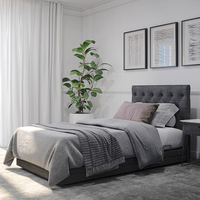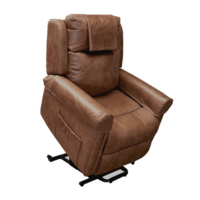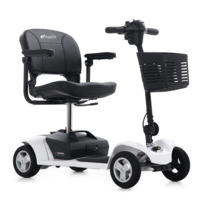What bariatric equipment is available?
There is a wide range of bariatric equipment available to support patients, including beds, chairs and mobility aids. Bariatric equipment is designed to be more robust than standard equipment and can help support the user while they’re resting, moving about or carrying out daily tasks.
Below are some of the most common bariatric equipment available.
Bariatric beds
Sleep is essential for our health. But people who are overweight can experience issues that make getting a good night’s sleep difficult. Bariatric beds provide adjustable positioning so patients can find a comfortable sleeping and resting position.
The range of bariatric beds includes hospital beds designed for use in medical settings as well as home care beds.
Homecare beds look a lot like a standard bed but they have a range of features that make them suitable for bariatric patients. This includes an adjustable backrest and footrest which allows the user to comfortably sit up in bed and find a comfortable sleeping position. Features can also include the ability to raise and lower the bed to make getting in and out much easier.
Bariatric chairs
One of the biggest challenges for bariatric patients is finding chairs that provide enough support while still being comfortable. Bariatric patients can often experience back, neck and spine issues that can make sitting for a long time uncomfortable. And getting in and out of standard chairs can often put extra strain on the body.
Bariatric chairs are essential for larger patients. These chairs have been designed to accommodate a larger size while enabling patients to sit and stand more easily.
The range of bariatric chairs can include day chairs, waiting room chairs and recliners.
Bariatric day chairs
Day chairs are ideal for everyday use in home and medical care settings. They often have a higher back, wider frame and plush padded seat for comfort with sturdy armrests to make it easier to get in and out of the chair.
Bariatric waiting room chairs
Similarly, bariatric waiting room chairs are designed to be durable and comfortable. With a clean, minimalist aesthetic that suits most waiting room decors, they are intended to blend in with the rest of the furniture and feel welcoming for all patients.
Bariatric lift chairs
Bariatric recliner chairs are ideal for all-day comfort in the home. They provide a plush, supportive spot to sit, recline and even nap during the day.
Bariatric lift chairs offer the same features as a standard lift and recline chair in a more robust design. As well as offering the ability to recline to almost a fully-flat position, lift chairs also rise forward, helping to lift the user to a standing position. For bariatric patients who may find it difficult to get out of standard chairs, this can reduce the effort and strain from standing and even encourage more movement and independence.
It’s important to look for a lift chair that has been designed for bariatric patients as they’ll often have a wider seat, higher backrest and larger motor. Importantly, the user should be able to sit comfortably with the feet resting on the floor and legs at a 90-degree angle when in the standard seated position.
Find out more about lift chairs and what to look for in our Buyer's Guide to Lift Recliner Chairs.
Bariatric scooters
Mobility scooters are an ideal way for people with limited mobility to get around. They have become more popular in recent years and it’s not uncommon to see them on the sidewalk or throughout shopping centres.
Compact and convenient, a mobility scooter can be used to move around at home, head down to the shops or travel even further when used on public transport.
Mobility scooters come in a range of sizes with the larger versions being ideal for bariatric users – some styles are able to carry up to 180kg total load. These heavy-duty scooters come with a comfortable seat, easy to use tiller handles, and space for bags and groceries.
With their robust motor, they can navigate steep hills and travel for up to 50km/h on a single charge.
Our Buyer’s Guide to Mobility Scooters has more information on the mobility scooters available and what to look for.
Bariatric walking aids
Walkers and rollators can be helpful for bariatric patients. Both of these options provide stability to people who have difficulty walking. By taking some of the weight off the body, they can reduce the impact of walking on the knees and joints.
Walkers and rollators can be particularly useful when it comes to transfers by providing sturdy support as the user goes from a seated to standing position.
A walker or rollator with an inbuilt seat can be helpful for bariatric patients looking to increase their physical activity by allowing them to rest and recover while out and about.
Bariatric bathroom aids
Bariatric patients may need assistance with everyday tasks and this can make personal care more difficult. Bariatric bathroom aids can provide stability and increase independence for when using this space.
Toilet aids sit over the toilet and help the user to transfer on and off. And the wide seat provides comfort and a sense of stability when seated.
Shower chairs and stools make showering in privacy easier. The wide, sturdy seat provides a safe place to sit while washing. And the raised armrests make it easier to get in and out of the shower.
Bariatric Lifters and Slings
Bariatric recliner chairs are ideal for all-day comfort in the home. They provide a plush, supportive spot to sit, recline and even nap during the day.
Bariatric lift chairs offer the same features as a standard lift and recline chair in a more robust design. As well as offering the ability to recline to almost a fully-flat position, lift chairs also rise forward, helping to lift the user to a standing position. For bariatric patients who may find it difficult to get out of standard chairs, this can reduce the effort and strain from standing and even encourage more movement and independence.
It’s important to look for a lift chair that has been designed for bariatric patients as they’ll often have a wider seat, higher backrest and larger motor. Importantly, the user should be able to sit comfortably with the feet resting on the floor and legs at a 90-degree angle when in the standard seated position.
Find out more about lift chairs and what to look for in our guide to lift chairs.





































